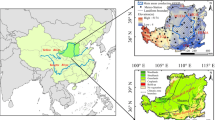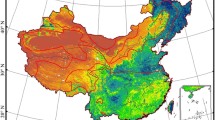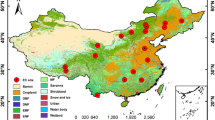Abstract
Terrestrial ecosystem water use efficiency (WUE) is an important indicator for coupling plant photosynthesis and transpiration, and is also a key factor linking the carbon and water cycles between the land and atmosphere. However, under the combination of climate change and human intervention, the change in WUE is still unclear, especially on the Tibetan Plateau (TP). Therefore, satellite remote sensing data and process-based terrestrial biosphere models (TBMs) are used in this study to investigate the spatiotemporal variations of WUE over the TP from 2001 to 2010. Then, the effects of land use and land cover change (LULCC) and CO2 fertilization on WUE from 1981–2010 are assessed using TBMs. Results show that climate change is the leading contributor to the change in WUE on the TP, and temperature is the most important factor. LULCC makes a negative contribution to WUE (−20.63%), which is greater than the positive contribution of CO2 fertilization (11.65%). In addition, CO2 fertilization can effectively improve ecosystem resilience on the TP. On the northwest plateau, the effects of LULCC and CO2 fertilization on WUE are more pronounced during the driest years than the annual average. These findings can help researchers understand the response of WUE to climate change and human activity and the coupling of the carbon and water cycles over the TP.
摘 要
陆地生态系统水分利用效率 (WUE) 是衡量陆地生态系统碳水耦合程度的关键指标, 也是描述植被在不同生长环境中水分适应策略的一个重要参数. 本文利用卫星遥感数据和陆地生物圈模式 (TBMs) 的多模型集合模拟, 研究了青藏高原水分利用效率的时空演变规律, 并定量评估了土地利用和土地覆盖变化 (LULCC) 以及 CO2施肥对水分利用效率的影响. 结果表明, 气候变化是影响青藏高原水分利用效率变化的主要因素, 土地利用和土地覆盖变化和 CO2施肥对水分利用效率的贡献分别为 −20.63% 和 11.65%. 此外, CO2 施肥可以有效地提高青藏高原的生态系统恢复力; 在青藏高原西北地区, 土地利用和土地覆盖变化和 CO2 施肥对水分利用效率的影响在最干旱的年份更为明显. 本研究有助于更好地理解青藏高原的生态水文过程及其影响机制, 并可为区域生态建设提供科学依据.
Similar content being viewed by others
References
Brutsaert, W., 2015: A generalized complementary principle with physical constraints for land-surface evaporation. Water Resour. Res., 51(10), 8087–8093, https://doi.org/10.1002/2015WR017720.
Chen, H., and Coauthors, 2013: The impacts of climate change and human activities on biogeochemical cycles on the Qinghai-Tibetan Plateau. Global Change Biology, 19(10), 2940–2955, https://doi.org/10.1111/gcb.12277.
Dias, L. C. P., M. N. Macedo, M. H. Costa, M. T. Coe, and C. Neill, 2015: Effects of land cover change on evapotranspiration and streamflow of small catchments in the upper Xingu river basin, central Brazil. J. Hydrol., 4, 108–122, https://doi.org/10.1016/j.ejrh.2015.05.010.
Douglas, E. M., J. M. Jacobs, D. M. Sumner, and R. L. Ray, 2009: A comparison of models for estimating potential evapotranspiration for Florida land cover types. J. Hydrol., 373(3–4), 366–376, https://doi.org/10.1016/j.jhydrol.2009.04.029.
El Masri, B., and Coauthors, 2019: Carbon and water use efficiencies: A comparative analysis of ten terrestrial ecosystem models under changing climate. Scientific Reports, 9(1), 14680, https://doi.org/10.1038/s41598-019-50808-7.
Evans, S. G., S. M. Ge, C. I. Voss, and N. P. Molotch, 2018: The role of frozen soil in groundwater discharge predictions for warming alpine watersheds. Water Resour. Res., 54(3), 1599–1615, https://doi.org/10.1002/2017WR022098.
Fang, Q. Q., G. Q. Wang, T. X. Liu, B. L. Xue, W. C. Sun, and S. Shrestha, 2020: Unraveling the sensitivity and nonlinear response of water use efficiency to the water-energy balance and underlying surface condition in a semiarid basin. Science of the Total Environment, 699, 134405, https://doi.org/10.1016/j.scitotenv.2019.134405.
Guo, L. M., and Coauthors, 2019: Response of ecosystem water use efficiency to drought over China during 1982–2015: Spatiotemporal variability and resilience. Forests, 10(7), 598, https://doi.org/10.3390/f10070598.
Hagedorn, R., F. J. Doblas-Reyes, and T. N. Palmer, 2005: The rationale behind the success of multi-model ensembles in seasonal forecasting—I. basic concept. Tellus A: Dynamic Meteorology and Oceanography, 57(3), 219–233, https://doi.org/10.3402/tellusa.v57i3.14657.
Huang, M. T., and Coauthors, 2015: Change in terrestrial ecosystem water-use efficiency over the last three decades. Global Change Biology, 21(6), 2366–2378, https://doi.org/10.1111/gcb.12873.
Huntzinger, D. N., and Coauthors, 2013: The North American carbon program multi-scale synthesis and terrestrial model inter-comparison project—Part 1: Overview and experimental design. Geoscientific Model Development, 6, 2121–2133, https://doi.org/10.5194/gmd-6-2121-2013.
Jia, B. H., and Coauthors, 2020: Impacts of land use change and elevated CO2 on the interannual variations and seasonal cycles of gross primary productivity in China. Earth System Dynamics, 11(1), 235–249, https://doi.org/10.5194/esd-11-235-2020.
Jung, M., and Coauthors, 2011: Global patterns of land-atmosphere fluxes of carbon dioxide, latent heat, and sensible heat derived from eddy covariance, satellite, and meteorological observations. J. Geophys. Res., 116(G3), G00J07, https://doi.org/10.1029/2010JG001566.
Jung M., and Coauthors, 2017: Compensatory water effects link yearly global land CO2 sink changes to temperature. Nature, 541(7638), 516–520, https://doi.org/10.1038/nature20780.
Knapp, A. K., and M. D. Smith, 2001: Variation among biomes in temporal dynamics of aboveground primary production. Science, 291(5503), 481–484, https://doi.org/10.1126/science.291.5503.481.
Lamsal, P., L. Kumar, F. Shabani, and K. Atreya, 2017: The greening of the Himalayas and Tibetan Plateau under climate change. Global and Planetary Change, 159, 77–92, https://doi.org/10.1016/j.gloplacha.2017.09.010.
Lavergne, A., H. Graven, M. G. De Kauwe, T. F. Keenan, B. E. Medlyn, and I. C. Prentice, 2019: Observed and modelled historical trends in the water-use efficiency of plants and ecosystems. Global Change Biology, 25, 2242–2257, https://doi.org/10.1111/gcb.14634.
Li, G., F. M. Zhang, Y. S. Jing, Y. B. Liu, and G. Sun, 2017: Response of evapotranspiration to changes in land use and land cover and climate in China during 2001–2013. Science of the Total Environment, 596–597, 256–265, https://doi.org/10.1016/j.scitotenv.2017.04.080.
Li, X.-L., J. Gao, G. Brierley, Y.-M. Qiao, J. Zhang, and Y.-W. Yang, 2013: Rangeland degradation on the Qinghai-Tibet Plateau: Implications for rehabilitation. Land Degradation & Development, 24(1), 72–80, https://doi.org/10.1002/ldr.1108.
Liu, J. G., B. H. Jia, Z. H. Xie, and C. X. Shi, 2016: Ensemble simulation of land evapotranspiration in China based on a multi-forcing and multi-model approach. Adv. Atmos. Sci., 33(6), 673–684, https://doi.org/10.1007/s00376-016-5213-0.
Liu, X. F., X. M. Feng, and B. J. Fu, 2020: Changes in global terres-trial ecosystem water use efficiency are closely related to soil moisture. Science of the Total Environment, 698, 134165, https://doi.org/10.1016/j.scitotenv.2019.134165.
Liu, Y. B., W. M. Ju, H. L. He, S. Q. Wang, R. Sun, and Y. D. Zhang, 2013a: Changes of net primary productivity in China during recent 11 years detected using an ecological model driven by MODIS data. Frontiers of Earth Science, 7(1), 112–127, https://doi.org/10.1007/s11707-012-0348-5.
Liu, Y., and Coauthors, 2013b: Evapotranspiration and water yield over China’s landmass from 2000 to 2010. Hydrology and Earth System Sciences, 17(12), 4957–4980, https://doi.org/10.5194/hess-17-4957-2013.
Luo, X., B. H. Jia, and X. Lai, 2020: Contributions of climate change, land use change and CO2 to changes in the gross primary productivity of the Tibetan Plateau. Atmos. Ocean. Sci. Lett., 13(1), 8–15, https://doi.org/10.1080/16742834.2020.1695515.
Ma, N., J. Szilagyi, Y. S. Zhang, and W. B. Liu, 2019: Complementary-relationship-based modeling of terrestrial evapotranspiration across China during 1982–2012: Validations and spatiotemporal analyses. J. Geophys. Res., 124(8), 4326–4351, https://doi.org/10.1029/2018JD029850.
Niu, S. L., X. R. Xing, Z. Zhang, J. Y. Xia, X. H. Zhou, B. Song, L. H. Li, and S. Q. Wan, 2011: Water-use efficiency in response to climate change: From leaf to ecosystem in a temperate steppe. Global Change Biology, 17(2), 1073–1082, https://doi.org/10.1111/j.1365-2486.2010.02280.x.
Ponce-Campos, G. E., and Coauthors, 2013: Ecosystem resilience despite large-scale altered hydroclimatic conditions. Nature, 464(7437), 349–352, https://doi.org/10.1038/nature11836.
Running, S. W., P. E. Thornton, R. Nemani, and J. M. Glassy, 2000: Global terrestrial gross and net primary productivity from the earth observing system. Methods in Ecosystem Science, O. E. Sala et al., Eds., Springer, 44–57, https://doi.org/10.1007/978-1-4612-1224-9_4.
Schwalm, C. R., and Coauthors, 2015: Toward “optimal” integration of terrestrial biosphere models. Geophys. Res. Lett., 42(11), 4418–4428, https://doi.org/10.1002/2015GL064002.
Sharma, A., and M. K. Goyal, 2018a: Assessment of ecosystem resilience to hydroclimatic disturbances in India. Global Change Biology, 24(2), e432–e441, https://doi.org/10.1111/gcb.13874.
Sharma, A., and M. K. Goyal, 2018b: District-level assessment of the ecohydrological resilience to hydroclimatic disturbances and its controlling factors in India. J. Hydrol., 564, 1048–1057, https://doi.org/10.1016/j.jhydrol.2018.07.079.
Sheffield, J., E. F. Wood, and M. L. Roderick, 2012: Little change in global drought over the past 60 years. Nature, 491(7424), 435–438, https://doi.org/10.1038/nature11575.
Shen, H., and Coauthors, 2019: Grazing enhances plant photosynthetic capacity by altering soil nitrogen in alpine grasslands on the Qinghai-Tibetan plateau. Agriculture, Ecosystems & Environment, 280, 161–168, https://doi.org/10.1016/j.agee.2019.04.029.
Siegel, A. F., and Wagner, M. R., 2022: Multiple regression: Predicting one variable from several others. Practical Business Statistics, 8th ed., A. F. Siegel and M. R. Wagner, Eds., Academic Press, 371–431, https://doi.org/10.1016/B978-0-12-820025-4.00012-9.
Song, L. N., J. J. Zhu, J. X. Zhang, T. Zhang, K. Wang, G. C. Wang, and J. H. Liu, 2019: Effect of drought and topographic position on depth of soil water extraction of Pinus sylvestris L. var. mongolica Litv. trees in a semiarid sandy region, Northeast China. Forests, 10(5), 370, https://doi.org/10.3390/f10050370.
Teuling, A. J., and Coauthors, 2013: Evapotranspiration amplifies European summer drought. Geophys. Res. Lett., 40(10), 2071–2075, https://doi.org/10.1002/grl.50495.
Tramontana, G., and Coauthors, 2016: Predicting carbon dioxide and energy fluxes across global FLUXNET sites with regression algorithms. Biogeosciences, 13(14), 4291–4313, https://doi.org/10.5194/bg-13-4291-2016.
Walker, B., C. S. Holling, S. R. Carpenter, and A. Kinzig, 2004: Resilience, adaptability and transformability in social-ecological systems. Ecology and Society, 9(2), 5, https://doi.org/10.5751/ES-00650-090205.
Wang, L. M., M. Y. Li, J. X. Wang, X. G. Li, and L. C. Wang, 2020: An analytical reductionist framework to separate the effects of climate change and human activities on variation in water use efficiency. Science of the Total Environment, 727, 138306, https://doi.org/10.1016/j.scitotenv.2020.138306.
Wang, W. G., J. X. Li, Z. B. Yu, Y. M. Ding, W. Q. Xing, and W. J. Lu, 2018: Satellite retrieval of actual evapotranspiration in the Tibetan Plateau: Components partitioning, multidecadal trends and dominated factors identifying. J. Hydrol., 559, 471–485, https://doi.org/10.1016/j.jhydrol.2018.02.065.
Wei, Y., and Coauthors, 2014: The North American carbon program multi-scale synthesis and terrestrial model intercomparison project—Part 2: Environmental driver data. Geoscientific Model Development, 7, 2875–2893, https://doi.org/10.5194/gmd-7-2875-2014.
Xia, J. Y., and Coauthors, 2017: Terrestrial ecosystem model performance in simulating productivity and its vulnerability to climate change in the northern permafrost region. J. Geophys. Res., 122, 430–446, https://doi.org/10.1002/2016JG003384.
Xu, H. J., X. P. Wang, and X. X. Zhang, 2016: Alpine grasslands response to climatic factors and anthropogenic activities on the Tibetan Plateau from 2000 to 2012. Ecological Engineering, 92, 251–259, https://doi.org/10.1016/j.ecoleng.2016.04.005.
Yang, Y. T., and Coauthors, 2016: Contrasting responses of water use efficiency to drought across global terrestrial ecosystems. Scientific Reports, 6(1), 23284, https://doi.org/10.1038/srep23284.
Yao, T. D., and Coauthors, 2017: From Tibetan Plateau to third pole and pan-third pole. Bulletin of the Chinese Academy of Sciences, 32(9), 924–931, https://doi.org/10.16418/j.issn.1000-3045.2017.09.001. (in Chinese with English abstract)
Yu, G. R., Z. Chen, S. L. Piao, C. H. Peng, P. Ciais, Q. F. Wang, X. R. Li, and X. J. Zhu, 2014: High carbon dioxide uptake by subtropical forest ecosystems in the East Asian monsoon region. Proceedings of the National Academy of Sciences of the United States of America, 111(13), 4910–4915, https://doi.org/10.1073/pnas.1317065111.
Yuan, M. S., and Coauthors, 2021: Global response of terrestrial gross primary productivity to climate extremes. Science of the Total Environment, 750, 142337, https://doi.org/10.1016/j.scitotenv.2020.142337.
Zhang, Y. L., and Coauthors, 2014: Spatial and temporal variability in the net primary production of alpine grassland on the Tibetan Plateau since 1982. Journal of Geographical Sciences, 24(2), 269–287, https://doi.org/10.1007/s11442-014-1087-1.
Zhao, M. S., and S. W. Running, 2010: Drought-induced reduction in global terrestrial net primary production from 2000 through 2009. Science, 329(5994), 940–943, https://doi.org/10.1126/science.1192666.
Acknowledgements
This work was supported by the Second Tibetan Plateau Scientific Expedition and Research Program (STEP) (Grant No. 2019QZKK0206), the Strategic Priority Research Program of Chinese Academy of Sciences (Grant No. XDA20100300), the Youth Innovation Promotion Association CAS (2021073), the National Key Scientific and Technological Infrastructure project “Earth System Science Numerical Simulator Facility” (EarthLab), the Natural Science Foundation of Hunan Province (Grant No. 2020JJ4074), and the Open Fund Project of Key Lab of Virtual Geographic Environment (Nanjing Normal University), Ministry of Education (2021VGE04).
Author information
Authors and Affiliations
Corresponding author
Additional information
Article Highlights
• The contributions of CO2 fertilization and land use land cover change (LULCC) to water use efficiency (WUE) are quantitatively assessed.
• Land use land cover change (LULCC) makes a negative contribution to water use efficiency (WUE), while there is an opposite effect from CO2 fertilization.
• Temperature is the most important climate factor in determining the changes of water use efficiency (WUE).
Rights and permissions
About this article
Cite this article
Jia, B., Luo, X., Wang, L. et al. Changes in Water Use Efficiency Caused by Climate Change, CO2 Fertilization, and Land Use Changes on the Tibetan Plateau. Adv. Atmos. Sci. 40, 144–154 (2023). https://doi.org/10.1007/s00376-022-2172-5
Received:
Revised:
Accepted:
Published:
Issue Date:
DOI: https://doi.org/10.1007/s00376-022-2172-5
Keywords
- water use efficiency
- gross primary productivity
- evapotranspiration
- Tibetan Plateau
- carbon and water cycle




